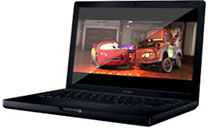Finally.
It's been four years since Apple discontinued the 12" PowerBook, and last week they finally
replaced it.
Yes, many considered the original plastic
MacBook as the replacement, and then came the MacBook Air with its shortage of
ports. Others called last year's (limited edition?) Unibody MacBook the true
replacement. The fact is that, until last Monday, there hadn't been a
Mac in the same weight or size class as the 12" PowerBook that was
equally feature-rich at any price.
What made the 12" PowerBook so special? As someone who has owned
these gems, I can honestly say that it was just the magic of perfect
proportion, the right feature set, and a jewel-like quality that made
the machine look and feel more like a Swiss watch than a mere laptop
computer. It had a keyboard that was wonderful, a case so small it was
sexy, and build quality that was way beyond anything else on the
market.
In short, it was a hard act to follow.
Each machine cited as a possible replacement fell short in some area
- and in terms of width, the new 13" MacBook Pro is
still too big - but only by an inch.
Polycarbonate MacBooks Fall Short
The plastic MacBooks looked and felt cheap, like the plastic iBooks they replaced. Poky
integrated graphics (pre-Nvidia) also didn't match the dedicated
graphics of the 12" PowerBook, at least in the context of their release
date.
 Weight and thickness were correct
though, and the black MacBook (especially) found its way into the
hearts of many former 12" PowerBook owners, myself included.
Weight and thickness were correct
though, and the black MacBook (especially) found its way into the
hearts of many former 12" PowerBook owners, myself included.
MacBook Air Falls Short
The MacBook Air actually beat-out the old 12" on style and
sex-appeal by quite a wide margin, but it was and remains too
compromised to count as a true replacement. Yes, it weighs a lot less
and is oh-so-thin, but one USB port and no optical drive put the MBA
solidly into the ultraportable class, rather than the lower size and
weight range of the business or thin-and-light class, which while thin
and light, also include a full complement of ports and features.
Unibody MacBook Came Closest
That leaves the 13" Unibody MacBook, which our own Charles Moore owns, as
does my daughter. The 13" Unibody was really close, and it's actually
more powerful in today's context than the 12" PowerBook was in the
context of 2003 to 2005. What it lacks, simply, is FireWire, which is
unimportant for many and a deal-killer for others. I can survive just
fine on USB, but FireWire's omission clearly pushed the MacBook down
from professional to consumer territory.
13" MacBook Pro Nearly Perfect
So now we have that same 13" Unibody MacBook, newly enhanced with a
built-in 7-hour battery, an SD Card slot, and the FireWire 800 port
(which honestly should have been there from the beginning). These
additions elevate the MacBook to the status of MacBook Pro, much as the
old 12" PowerBook was differentiated from the cheaper 12" iBook by
means of its superior keyboard, aluminum case, and graphics.
There are other improvements as well. Yes, there was the usual
speed-bump, but more importantly the new 13" MacBook Pro can address up
to 8 GB of RAM, which makes it more future-proof, and at the top
of the list, the screens are better quality, now equal to the exquisite
display on the MacBook Air. Except for the 1280 x 800 resolution, this
really may be the perfect laptop. And don't forget, while the rest of
Apple's PowerBooks were higher resolution and widescreen, the
much-loved 12" model made due with a mediocre-quality display at an
unimpressive 1024 x 768 resolution.
I honestly believe that the low-end 13" MacBook Pro is about the
best value there has ever been in an Apple laptop. I sold my 15"
MacBook Pro as soon as I learned of the new MacBook Pro and went to the
Apple Store to pick one up - but what I actually went home with and why
is a story for another day, perhaps tomorrow.

Andrew J Fishkin, Esq, is a laptop using attorney in Los Angeles, CA.

 Weight and thickness were correct
though, and the black MacBook (especially) found its way into the
hearts of many former 12" PowerBook owners, myself included.
Weight and thickness were correct
though, and the black MacBook (especially) found its way into the
hearts of many former 12" PowerBook owners, myself included.
